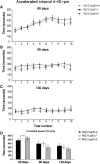Mitochondrial calcium uptake capacity as a therapeutic target in the R6/2 mouse model of Huntington's disease
- PMID: 20558522
- PMCID: PMC2916705
- DOI: 10.1093/hmg/ddq247
Mitochondrial calcium uptake capacity as a therapeutic target in the R6/2 mouse model of Huntington's disease
Abstract
Huntington's disease (HD) is an incurable autosomal-dominant neurodegenerative disorder initiated by an abnormally expanded polyglutamine domain in the huntingtin protein. It is proposed that abnormal mitochondrial Ca2+ capacity results in an increased susceptibility to mitochondrial permeability transition (MPT) induction that may contribute significantly to HD pathogenesis. The in vivo contribution of these hypothesized defects remains to be elucidated. In this proof-of-principle study, we examined whether increasing mitochondrial Ca2+ capacity could ameliorate the well-characterized phenotype of the R6/2 transgenic mouse model. Mouse models lacking cyclophilin D demonstrate convincingly that cyclophilin D is an essential component and a key regulator of MPT induction. Mitochondria of cyclophilin D knockout mice are particularly resistant to Ca2+ overload. We generated R6/2 mice with normal, reduced or absent cyclophilin D expression and examined the effect of increasing mitochondrial Ca2+ capacity on the behavioral and neuropathological features of the R6/2 model. A predicted outcome of this approach was the finding that cyclophilin D deletion enhanced the R6/2 brain mitochondria Ca2+ capacity significantly. Increased neuronal mitochondrial Ca2+ capacity failed to ameliorate either the behavioral and neuropathological features of R6/2 mice. We found no alterations in body weight changes, lifespan, RotaRod performances, grip strength, overall activity and no significant effect on the neuropathological features of R6/2 mice. The results of this study demonstrate that increasing neuronal mitochondrial Ca2+-buffering capacity is not beneficial in the R6/2 mouse model of HD.
Figures









Similar articles
-
Age-dependent changes in the calcium sensitivity of striatal mitochondria in mouse models of Huntington's Disease.J Neurochem. 2005 Jun;93(6):1361-70. doi: 10.1111/j.1471-4159.2005.03036.x. J Neurochem. 2005. PMID: 15935052
-
Tissue transglutaminase overexpression does not modify the disease phenotype of the R6/2 mouse model of Huntington's disease.Exp Neurol. 2012 Sep;237(1):78-89. doi: 10.1016/j.expneurol.2012.05.015. Epub 2012 Jun 12. Exp Neurol. 2012. PMID: 22698685 Free PMC article.
-
The absence of the aryl hydrocarbon receptor in the R6/1 transgenic mouse model of Huntington's disease improves the neurological phenotype.Behav Brain Res. 2021 Jun 25;408:113230. doi: 10.1016/j.bbr.2021.113230. Epub 2021 Mar 5. Behav Brain Res. 2021. PMID: 33684424
-
Role of mitochondrial dysfunction in the pathogenesis of Huntington's disease.Brain Res Bull. 2009 Oct 28;80(4-5):242-7. doi: 10.1016/j.brainresbull.2009.07.010. Epub 2009 Jul 19. Brain Res Bull. 2009. PMID: 19622387 Free PMC article. Review.
-
Mitochondrial calcium function and dysfunction in the central nervous system.Biochim Biophys Acta. 2009 Nov;1787(11):1416-24. doi: 10.1016/j.bbabio.2009.03.010. Epub 2009 Mar 17. Biochim Biophys Acta. 2009. PMID: 19298790 Free PMC article. Review.
Cited by
-
Mitochondrial Ca(2+) and neurodegeneration.Cell Calcium. 2012 Jul;52(1):73-85. doi: 10.1016/j.ceca.2012.04.015. Epub 2012 May 18. Cell Calcium. 2012. PMID: 22608276 Free PMC article. Review.
-
Hyperactivity and cortical disinhibition in mice with restricted expression of mutant huntingtin to parvalbumin-positive cells.Neurobiol Dis. 2014 Feb;62:160-71. doi: 10.1016/j.nbd.2013.10.002. Epub 2013 Oct 11. Neurobiol Dis. 2014. PMID: 24121117 Free PMC article.
-
Towards an Understanding of Energy Impairment in Huntington's Disease Brain.J Huntingtons Dis. 2017;6(4):267-302. doi: 10.3233/JHD-170264. J Huntingtons Dis. 2017. PMID: 29125492 Free PMC article. Review.
-
Neurodevelopmental impairment following neonatal hyperoxia in the mouse.Neurobiol Dis. 2013 Feb;50:69-75. doi: 10.1016/j.nbd.2012.10.005. Epub 2012 Oct 12. Neurobiol Dis. 2013. PMID: 23064437 Free PMC article.
-
Adeno-Associated Viral Vector Serotype DJ-Mediated Overexpression of N171-82Q-Mutant Huntingtin in the Striatum of Juvenile Mice Is a New Model for Huntington's Disease.Front Cell Neurosci. 2018 Jun 12;12:157. doi: 10.3389/fncel.2018.00157. eCollection 2018. Front Cell Neurosci. 2018. PMID: 29946240 Free PMC article.
References
-
- Folstein S.E. Huntington's Disease: a Disorder of Families. Baltimore: Johns Hopkins University Press; 1989.
-
- Hunter J.M., Crouse A.B., Lesort M., Johnson G.V., Detloff P.J. Verification of somatic CAG repeat expansion by pre-PCR fractionation. J. Neurosci. Methods. 2005;144:11–17. doi:10.1016/j.jneumeth.2004.10.006. - DOI - PubMed
-
- Trottier Y., Biancalana V., Mandel J.L. Instability of CAG repeats in Huntington's disease: relation to parental transmission and age of onset. J. Med. Genet. 1994;31:377–382. doi:10.1136/jmg.31.5.377. - DOI - PMC - PubMed
-
- Telenius H., Kremer B., Goldberg Y.P., Theilmann J., Andrew S.E., Zeisler J., Adam S., Greenberg C., Ives E.J., Clarke L.A., et al. Somatic and gonadal mosaicism of the Huntington disease gene CAG repeat in brain and sperm. Nat. Genet. 1994;6:409–414. doi:10.1038/ng0494-409. - DOI - PubMed
-
- Kennedy L., Evans E., Chen C.M., Craven L., Detloff P.J., Ennis M., Shelbourne P.F. Dramatic tissue-specific mutation length increases are an early molecular event in Huntington disease pathogenesis. Hum. Mol. Genet. 2003;12:3359–3367. doi:10.1093/hmg/ddg352. - DOI - PubMed
Publication types
MeSH terms
Substances
Grants and funding
LinkOut - more resources
Full Text Sources
Other Literature Sources
Medical
Molecular Biology Databases
Miscellaneous

